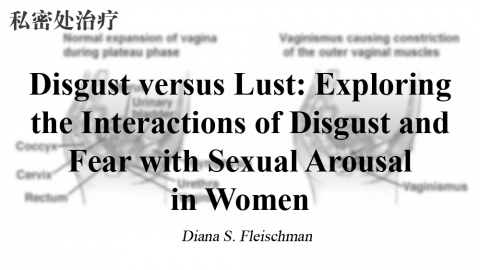
- 3694人
- 分享收藏
Disgust versus Lust: Exploring the Interactions of Disgust and Fear with Sexual Arousal in Women
简介
【 文献重点摘要 】
Sexual arousal is a motivational state that moves humans toward situations that inherently pose a risk of disease transmission. Disgust is an emotion that adaptively moves humans away from such situations. Incongruent is the fact that sexual activity is elementary to human fitness yet involves strong disgust elicitors. Using an experimental paradigm, we investigated how these two states interact. Women (final N=76) were assigned to one of four conditions: rate disgust stimuli then watch a pornographic clip; watch a pornographic clip then rate disgust stimuli; rate fear stimuli then watch a pornographic clip; or watch a pornographic clip then rate fear stimuli. Women’s genital sexual arousal was measured with vaginal photoplethysmography and their disgust and fear reactions were measured via self-report. We did not find that baseline disgust propensity predicted sexual arousal in women who were exposed to neutral stimuli before erotic content. In the Erotic-before-Disgust condition we did not find that sexual arousal straightforwardly predicted decreased image disgust ratings. However, we did find some evidence that sexual arousal increased self-reported disgust in women with high trait disgust and sexual arousal decreased self-reported disgust in women with low trait disgust. Women who were exposed to disgusting images before erotic content showed significantly less sexual arousal than women in the control condition or women exposed to fear-inducing images before erotic content. In the Disgust-before-Erotic condition the degree of self-reported disgust was negatively correlated with genital sexual arousal. Hence, in the conflict between the ultimate goals of reproduction and disease avoidance, cues of the presence of pathogens significantly reduce the motivation to engage in mating behaviors that, by their nature, entail a risk of pathogen transmission.
性唤醒是一种激励状态,它将人类推向天生具有疾病传播风险的情况。厌恶是一种情绪,它会适应性地使人类远离这种情况。不一致的事实是,性行为是人类健康的基本要素,但却牵涉到强烈的厌恶诱因。使用实验范式,我们研究了这两种状态是如何相互作用的。女性(最终N=76人)被分配到四种条件之一:先给厌恶刺激打分,然后看色情片断;看色情片断再给厌恶片子打分;给恐惧刺激打分,然后看色情片断;或者看色情片断再给恐惧片子打分。女性生殖器的性唤醒是用阴道光体积描记仪测量的,而她们的厌恶和恐惧反应是通过自我报告来测量的。我们没有发现,在性爱内容之前暴露于中性刺激的女性中,基线厌恶倾向预测了性唤起。在先性爱后厌恶的情况下,我们没有发现性唤醒直接预测形象厌恶程度的下降。然而,我们确实发现一些证据表明,性唤醒增加了高特质厌恶女性的自我报告厌恶,而性唤醒降低了低特质厌恶女性的自我报告厌恶。那些在色情内容之前接触到令人厌恶的图片的女性表现出的性唤醒明显低于控制条件下的女性或在色情内容之前接触到令人恐惧的图片的女性。在性爱前的厌恶状态下,自我报告的厌恶程度与生殖器的性唤醒呈负相关。因此,在生殖和避免疾病的最终目标之间的冲突中,病原体存在的线索大大降低了从事交配行为的动机,而交配行为本质上会带来病原体传播的风险。



